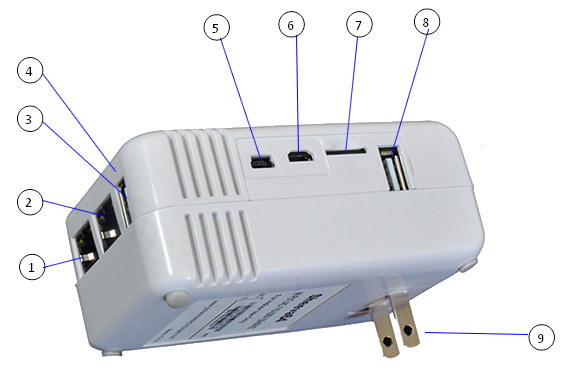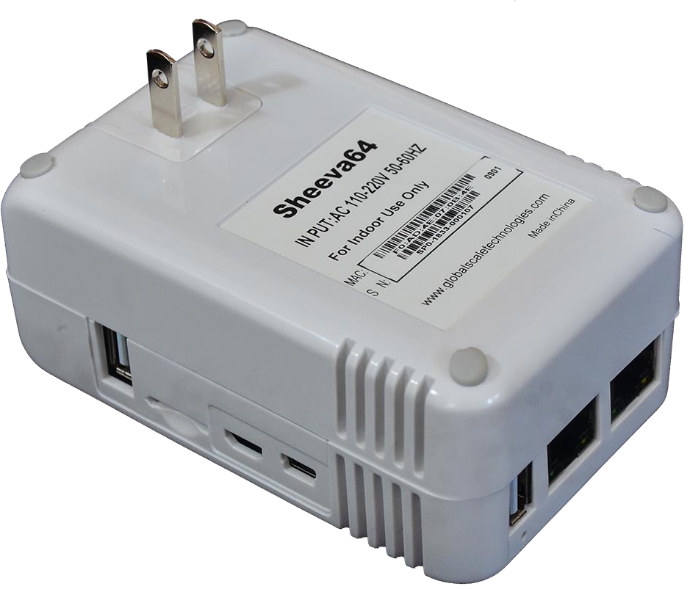Sheevaplug is a Linux plug computer powered by Marvell Kirkwood 6281 ARM9 processor that was launched in 2009 with Ubuntu 9.04. As the name implies, Sheevaplug looks like a power adapter that’s plug directly into your mains socket, but it’s actually a headless computer, i.e. without video output, and instead coming with a USB port, Gigabit Ethernet, and an SD card slot. The device got fairly popular at the time, so it ended up in several hardware projects, and was supported by a long list of open source software projects as you’ll find out in the Wikipedia page.
Ten years have passed, and Globalscale Technologies has just introduced an upgraded version with the Sheeva64 plug computer based on the same Marvell ARMADA 3720 dual core Armv8 processor as found in ESPRESSOBin board.
Sheeva64 plug computer specifications:
- SoC – Marvell ARMADA 3720 dual core 64bit Arm processor up to 1.2GHz
- System Memory – 1GB DDR4
- Storage – 4GB eMMC flash, 4MB SPI NOR flash, micro SD card slot (7)
- Networking
- 2x Gigabit Ethernet (1 & 2)
- Optional 2×2 ac Wi-Fi 5 and BLE 4.2 module
- USB – 2x USB Type A ports (3 & 8), 1x micro USB OTG port (6), 1x mini USB port (5) for console
- Misc – 1x RTC battery, reset pinhole (4), 2x user LEDs, 10-pin Cortex JTAG debug port
- Power Supply – Built-in 110-220V AC 50-60Hz power supply, 2-prong US plug (9)
- Dimensions – 110mm (L) x 70mm (W) x 49 mm (H)
 The Sheeva64 plug computer ships with Ubuntu 18.04 pre-loaded, and for debugging the company recommends a PC running Fedora 14 or greater as they provide binary drivers for the FTDI device in the plug computer.
The Sheeva64 plug computer ships with Ubuntu 18.04 pre-loaded, and for debugging the company recommends a PC running Fedora 14 or greater as they provide binary drivers for the FTDI device in the plug computer.
The device ships with a a Cat 5e Ethernet cable, a mini USB to USB cable, an AC power cord, and a warranty card. Wait.. What? An AC power cord? Yes, as it looks like the 2-prong plug can be removed, and you can insert a standard power cord instead. They also mention an internal SATA cable in the list of accessories, but the specifications and block diagram below do not show any SATA interface.
 The plug computer will start shipping in April 2019, but you can pre-order now without credit card for $89 on the product page. Make sure you don’t enter your credit card details, and select “pre-order” or you’ll be charged.
The plug computer will start shipping in April 2019, but you can pre-order now without credit card for $89 on the product page. Make sure you don’t enter your credit card details, and select “pre-order” or you’ll be charged.
Thanks to Willy and Adam for the tip.

Jean-Luc started CNX Software in 2010 as a part-time endeavor, before quitting his job as a software engineering manager, and starting to write daily news, and reviews full time later in 2011.
Support CNX Software! Donate via cryptocurrencies, become a Patron on Patreon, or purchase goods on Amazon or Aliexpress





